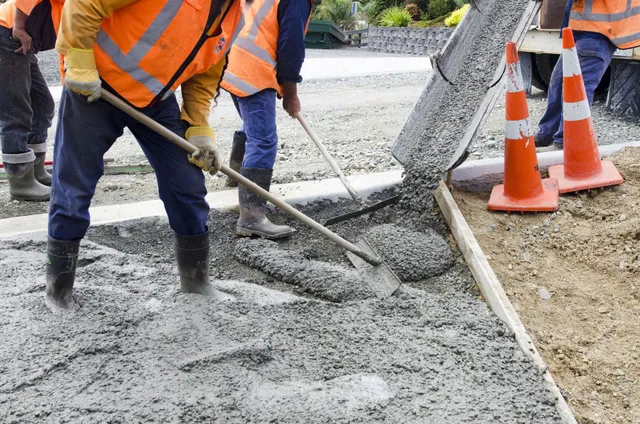A Concrete Crew Carrallton TX follows a series of steps to prepare the worksite effectively, from site clearing and excavation to layout marking and formwork installation.

Here’s a detailed guide on how a concrete crew prepares a worksite for pouring concrete:
- Site Evaluation and Planning: Before commencing any construction activities, the concrete crew conducts a thorough evaluation of the worksite to assess site conditions, soil stability, drainage patterns, and any potential obstacles or hazards. They review project plans, specifications, and design drawings to understand the scope of work and requirements for the concrete structure.
- Site Clearing and Excavation: The crew clears the construction site of vegetation, debris, and obstructions using heavy equipment such as excavators, bulldozers, or skid-steer loaders. They remove any existing structures, utilities, or obstacles that may interfere with the concrete construction process. Excavation begins to remove soil to the required depth for the concrete foundation or slab. The crew carefully excavates the area, ensuring proper slope and grade for drainage and compaction.
- Grading and Compaction: After excavation, the crew grades and levels the soil surface to provide a stable base for the concrete foundation or slab. They use grading equipment, such as motor graders or compactors, to achieve the desired slope, elevation, and compaction density. Compaction is crucial to ensure soil stability and prevent settlement or shifting of the concrete structure over time. The crew compacts the soil layers using heavy rollers or vibratory compactors, following specified compaction standards and testing requirements.
- Layout Marking and Surveying: With the site cleared and graded, the crew marks the layout and dimensions of the concrete structure using surveying equipment, layout tools, and string lines. They establish reference points, grid lines, and elevation benchmarks to guide the placement and alignment of formwork and reinforcement. Accurate layout marking is essential for ensuring the correct positioning and dimensions of the concrete structure relative to project plans and specifications. The crew verifies layout measurements and alignments to minimize errors and discrepancies during construction.
- Formwork Installation: Formwork, also known as molds or shuttering, is erected to contain and shape the freshly poured concrete. The crew assembles and installs formwork panels, beams, and supports according to the layout markings and design drawings. Formwork may be constructed from wood, metal, or prefabricated systems, depending on the complexity and requirements of the concrete structure. The crew ensures tight joints, proper alignment, and sufficient bracing to withstand the pressure of the concrete placement.
- Reinforcement Placement: Reinforcement materials, such as rebar, mesh, or fibers, are positioned and secured within the formwork to enhance the strength and durability of the concrete. The crew follows reinforcement drawings and specifications to place rebar at the correct locations and spacings. Proper reinforcement placement is critical for structural integrity and load-bearing capacity. The crew ensures adequate cover and clearance between reinforcement bars and formwork to prevent corrosion and ensure proper concrete consolidation.
- Utility Protection and Coordination: The crew identifies and locates underground utilities, pipelines, and services that may be affected by concrete construction activities. They take measures to protect and avoid damage to utilities by using utility locators, ground-penetrating radar, or hand excavation techniques. Coordination with utility companies, municipalities, and project stakeholders is essential to ensure compliance with safety regulations and minimize disruptions to utility services during construction.
- Safety Precautions and Hazard Mitigation: Prior to concrete pouring, the crew implements safety precautions and hazard mitigation measures to ensure a safe work environment. They conduct a pre-pour safety briefing to review potential hazards, emergency procedures, and PPE requirements. Safety barriers, guardrails, and fall protection systems are installed to prevent falls and accidents around excavations and elevated work areas. The crew secures loose materials, equipment, and tools to prevent tripping hazards and ensure site cleanliness.
- Environmental Protection Measures: Environmental protection measures are implemented to minimize the impact of construction activities on the surrounding environment. The crew installs erosion control measures, such as silt fences, straw mulch, or erosion blankets, to prevent soil erosion and sedimentation in nearby water bodies. Sediment and erosion control practices are essential for compliance with environmental regulations and preservation of water quality. The crew also implements dust control measures, such as water spraying or dust suppressants, to minimize airborne dust emissions from excavation and construction activities.
- Final Site Inspection and Readiness Assessment: Before concrete pouring begins, the crew conducts a final inspection of the worksite to ensure that all preparations are complete and compliant with project requirements. They check formwork stability, reinforcement placement, layout accuracy, and safety measures. A readiness assessment is performed to confirm that all necessary materials, equipment, and personnel are in place for concrete placement. Any remaining issues or deficiencies are addressed, and corrective actions are taken to ensure the successful execution of the concrete construction process.
Concrete Crew Carrallton TX Attention to detail, adherence to safety protocols, and effective coordination among crew members are essential for achieving optimal results and minimizing risks and delays during the concrete construction process.
Concrete Crew
2535 Oak Tree Dr, Carrollton, TX 75006, United States
1-972-845-8931
